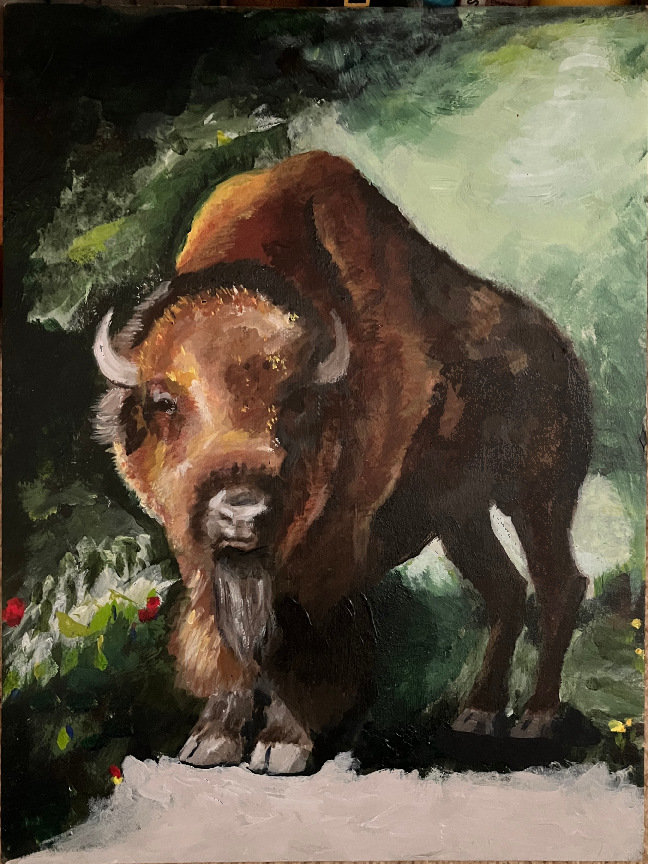American Buffalo
Bison

The American bison, commonsensically called bison bison by the cognoscenti, are the biggest land animals in the Americas. Adult males can easily hit 2000 lbs and the females can reach about half that.
There are two subspecies. One is the plains bison, bison bison bison, and the wood bison, bison bison athabasscae.
Yes, as everyone knows, bison were almost hunted to extinction. From literally tens of millions of animals roaming the Great Plains before the mid-19th Century, they had been whittled down to maybe 400 animals in the mid-1880's. The numbers cited today seem confusing, some sources saying maybe there's 30,000 animals in the United States, but others say the number is more like 350,000 and nearly 200,000 in Canada. Part of the confusion, though, is foisted by some animals being wild, some on Federal lands in the US, and others on privately owned lands. But in any case, bison are no longer considered a threatened species.
Readers who see the rendition above - painted in acrylics - will wonder just where the heck is the tail, for crying out loud? Well, bison's tails are quite short, much shorter than a cow's, and in many pictures you don't even see it.
All Americans know that the bison is the National Animal of the United States. Up until the mid-19th Century it provided essentially all the needs of the Native Plains Tribes. The hide provided clothes and coverings for the lodges, as well as blankets and bedding. The meat produced almost all the calories of the diet and the high protein content was why the natives were larger than the inhabitants of European descent. The bison is truly the quintessential American animal.
And yes, almost everyone calls them "buffalo". This, though, if we might borrow a turn from the reformation historian John Strype, "... is a small error, but being so oft repeated deserveth to be observed and corrected." Such a mistake "is not to be followed by learned men."
Less known to to the Yanks, though, is the European bison, the wisent. Lest Americans encounter embarrassment when speaking to those from the Eurasian continent, the pronunciation is VEE-zent.
And yes, sometimes the wisent is called a European buffalo.
At first glance, an American would think the wisent was a bison which hadn't been eating its Wheaties. It has a smaller hump and has a longer body that its American cousin. Although on the average it stands a bit taller, it is less massive with males tipping the scale at about 1400 pounds. The ladies, though, are more at par with their American counterparts and can reach half a ton. The wisent also has a bit longer tail, and it's fur isn't quite as shaggy.
The wisent, scientists have decided, was in fact a hybid of the now extinct steppe bison (Bison priscus) and the aurochs (Bos primigenius) which are believed to be the ancestor of modern cattle. On the other hand, the American bison is pretty much a direct descendent of the Steppe bison which wandered over the Siberian-Bering land bridge and got sized down to Bison antiquus. Bison antiquus was hunted as late as 10,000 years ago when it got even smaller and became our Bison bison.
Like the American bison, the wisent almost went extinct due to overhunting but not during the days of the Old West. Instead, their population nadir was immediately following the First World War. In fact, the wisent came nearer to extinction than the American species and by the late 1920's it was down to the last few individuals that were kept in zoos. But now there are about 1000 individuals on nature preserves in Europe.
Although technically it is possible to produce hybrids from the American bison and the wisent, their distinct physiognomy and physical separation keeps the American and European bison classified as separate species, the wisent being bison bonasus. Wisents in American zoos seem few and far between, and a diligent search failed to find any zoos that list a wisent in their collection.
So Americans can honestly say, "Yes, we have no bonasus.
References and Further Reading
Bison: Symbol of the American West, Michael Sample, Falcon Publishing, 1987.
"15 Facts About Our National Mammal: The American Bison", US Department of Interior, November 3, 2022.
"Bison Evolution and Zoogeography in North America During the Pleistocene", R. D. Guthrie, The Quarterly Review of Biology, Volume 45, Number 1.
"Bison Bellows: A Bottleneck of Bison", National Park Service.
"Bison by the Numbers: Data & Statistics", National Bison Association.
"Bison Population by State", World Population Review..
"Mysterious Origin of European Bison Revealed Using DNA and Cave Art", Emma Marris, Nature, 2016.
European Bison: The Nature Monograph, Małgorzata Krasińska, Zbigniew Krasiński, 2008.
Der Wisent: Bison bonasus, Małgorzata Krasińska, 2008.
Zooführer (Wisent), Tierpark Hellabrunn München, 1966.
Wisent und Elch. Zwei urige Recken, Dr. Kurt Floericke, Franckh, Stuttgart, 1930.
Memorials of the Most Reverend Father in God Thomas Cranmer, Sometime Lord Archbishop of Canterbury: Wherein the History of the Church, and the Reformation of It During the Primacy of the Said Archbishop, Are Greatly Illustrated; and Many Singular Matters Relating Thereunto, Now First Published (1694) in Three Books, John Strype, Chiswell, 1694, (Reprint: Oxford: Clarendon Press, 1812).